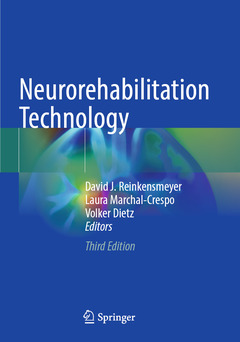Neurorehabilitation Technology (3rd Ed., 3rd ed. 2022)
Coordonnateurs : Reinkensmeyer David J., Marchal-Crespo Laura, Dietz Volker

This revised, updated, and substantially expanded third edition provides an accessible, practical overview of major areas of research, technical development and clinical application in the field of neurorehabilitation movement therapy. The initial section provides the basic framework and a rationale for technology application in movement therapy by summarizing recent findings in neuroplasticity and motor learning. The following section provides a detailed overview of the movement physiology of various neurologic conditions, illustrating how this knowledge has been used to design various neurorehabilitation technologies. The third section then explains the principles of human-machine interaction for movement rehabilitation. The fourth section provides an overview of assessment technology and predictive modeling in neurorehabilitation. The fifth section provides a survey of technological approaches to neurorehabilitation, including spinal cord stimulation, functional electrical stimulation, virtual reality, wearable sensing, brain computer interfaces, mobile technologies, and telerehabilitation. The final two sections examine in greater detail the ongoing revolution in robotic therapy for upper extremity movement and walking, respectively. The promises and limitations of these technologies in neurorehabilitation are discussed, including an Epilogue which debates the impact and utility of robotics for neurorehabilitation. Throughout the book the chapters provide detailed practical information on state-of-the-art clinical applications of these devices following stroke, spinal cord injury, and other neurologic disorders and future developments in the field. The text is illustrated throughout with photographs and schematic diagrams which serve to clarify the information for the reader.
Neurorehabilitation Technology, Third Edition is a valuable resource for neurologists, biomedical engineers, roboticists, rehabilitation specialists, physiotherapists, occupational therapists and those training in these fields.
Chapter ?Spinal Cord Stimulation to Enable Leg Motor Control and Walking in People with Spinal Cord Injury is available open access under a Creative Commons Attribution 4.0 International License via link.springer.com.
David Reinkensmeyer is Professor in the Departments of Mechanical and Aerospace Engineering, Anatomy and Neurobiology, Biomedical Engineering, and Physical Medicine and Rehabilitation at the University of California Irvine. His research interests are in neuromuscular control, motor learning, robotics, and rehabilitation. A major goal of his research is to develop physically interacting, robotic and mechatronic devices to help the nervous system recover the ability to control movement of the arm, hand, and leg after neurologic injuries such as stroke and spinal cord injury. He is also investigating the computational mechanisms of human motor learning in order to provide a rational basis for designing movement training devices. He is Editor-in-Chief of the Journal of Neuroengineering and Rehabilitation. His laboratory has helped develop a variety of robotic devices for manipulating and measuring movement in humans and rodents, including two devices that have been successfully commercialized as Flint Rehabilitation’s MusicGlove and as Hocoma’s ArmeoSpring. He is a fellow of the American Institute for Medical and Biological Engineering.
Laura Marchal-Crespo is Associate Professor at the Department of Cognitive Robotics, Faculty 3mE (Mechanical, Maritime and Materials Engineering), Delft University of Technology, The Netherlands. Her research focuses on the general areas of human-machine interaction and biological learning and, in particular, the use of robotic devices and immersive virtual reality for the assessment and rehabilitation of patients with acquired brain injuries such as stroke. A major goal of her research is to gain a better understanding of the underlying mechanisms associated with the acquisition of novel motor skills in order to develop innovative technology to improve neurorehabilitation. She develops intelligent controllers that modulate movement errors based on patients’ special needs, age, and training task characteristics using a wide sel
Features new chapters covering the application of mobile technologies and wearable sensors
Consolidates significant advances in the field and the implications for clinical practice in neurorehabilitation
Written by international experts supporting neurorehabilitation
Date de parution : 11-2023
Ouvrage de 785 p.
17.8x25.4 cm
Disponible chez l'éditeur (délai d'approvisionnement : 15 jours).
Prix indicatif 105,49 €
Ajouter au panierDate de parution : 11-2022
Ouvrage de 785 p.
17.8x25.4 cm
Disponible chez l'éditeur (délai d'approvisionnement : 15 jours).
Prix indicatif 147,69 €
Ajouter au panier


